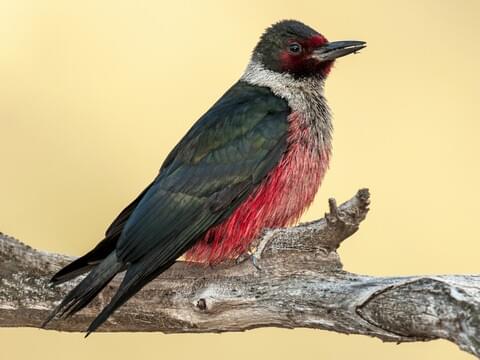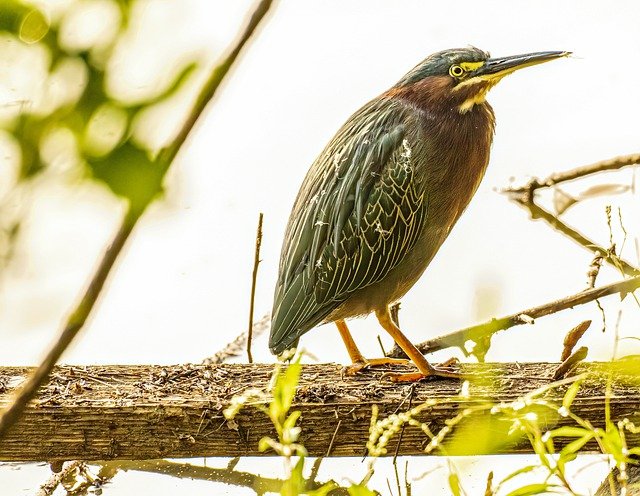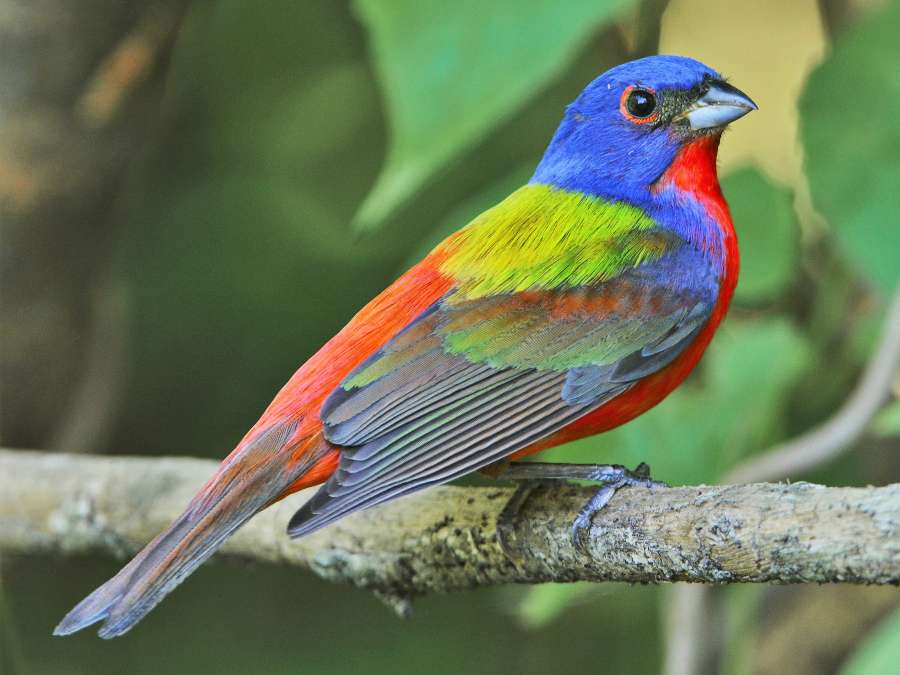Although green colored birds aren’t the easiest to come by, you can still find the odd few within New Mexico. In this article I’ll be covering 5 unique green birds that can be seen in New Mexico so, continue reading to learn more about them.
- Lewis’s Woodpecker
- Violet Green Swallow
- Red Eyed Vireo
- Green Heron
- Painted Bunting
5 Green Birds In New Mexico
1. Lewis’s Woodpecker (Melanerpes Lewis)

- Size: 25 – 28cm
- Weight: 110 – 130 grams
- Wingspan: 49 – 52cm
You’ll find Lewis’s woodpeckers in southern and eastern New Mexico in their non-breeding season but, they do happen to stick around the remainder of the state year round.
Lewis’s woodpecker is recognised by their red, black and dark green plumage where their wings and back are black in color, their breast and face have elements of red and their neck a mostly white/gray color. Females are mostly white and gray,
These woodpeckers can be found in open ponderosa pine forests and burned forests with a high density of standing dead trees. They will also breed near streamsides, oak woodlands, orchards, and pinyon-juniper woodlands.
Lewis’s woodpeckers mostly eat insects that they catch flying in mid-air or found on branches and trees, nuts along with a variety of seeds.
As for how long these woodpeckers are known to live for, it can be anywhere from 4 – 12 years.
2. Violet Green Swallow (Tachycineta Thalassina)

- Size: 13 – 14cm
- Weight: 13 – 15 grams
- Wingspan: 26 – 28cm
Violet green swallows tend to spend their spring and summer breeding months everywhere in New Mexico but the eastern border of the state.
These swallows are recognised by their darker green upper back and upper head, graysish/green wings and tail feathers along with a white face and breast. Females look very similar to the males.
Violet green swallows can be found around deciduous and coniferous forest where you’ll see them nesting within tree holes.
These swallows feed on a variety flying insects like flies, true bugs, wasps, winged ants, wild bees, beetles, moths etc. like most others. They will also eat the occasional berry or seed if they come across some.
The oldest recorded violet green swallow lived for 9 years and 1 month but, the typical lifespan for these birds will be at least a couple years less.
3. Red Eyed Vireo (Vireo Olivaceus)

- Size: 11 – 13cm
- Weight: 20 – 24 grams
- Wingspan: 23 – 25cm
Red eyed vireos can be found migrating through the Eastern bored of the state.
These vireos are recognised by there green feathers from the head, wings and back, white feathers on their breast and the stand out red eye. The females look very similar to the males.
As for where you’ll often see these birds perching or flying around, it would include environments with large expanses of deciduous forest, particularly deciduous trees with large leaves, like maple trees for example.
Red eyed vireos tend to eat mostly insects like caterpillars, moths, beetles, wasps, bees, ants, bugs, flies, as well as the occasional fruit and berry.
Red eyed vireos tend to live for around 6 – 7 years, whilst the oldest recorded one died at 10 years and 2 months.
4. Green Heron (Butorides Virescens)

- Size: 40 – 44cm
- Weight: 230 – 250 grams
- Wingspan: 54 – 58cm
You’ll find green herons in southern New Mexico when wintering and they will generally use the remainder of the state as a migratory passage.
These heron’s are recognised by their darker green back and wings, maroon chest and neck, with yellow legs and a relatively long and pointy black beak. Females on the other hand are mostly brown and gray in color.
Green herons tend to spend the majority of their time around wetlands like lakes, ponds, marshes, swamps, streamsides and rivers.
As for what they consume, it includes a variety of different sources such as small fish like minnows, sunfishes, gizzard shads, crustaceans, aquatic insects, frogs, tadpoles, grasshoppers, snakes, earthworms, snails and other smaller rodents.
Green herons don’t have the longest of lifespans for a bird of their size, with the maximum known life expectancy said to be around 8 years.
5. Painted Bunting (Passerina Ciris)

- Size: 12 – 13cm
- Weight: 13 – 19 grams
- Wingspan: 21 – 23cm
Painted buntings can be spotted in smaller regions in south east New Mexico when they happen to breed.
Although painted buntings come in a variety of colors where their neck, breast and lower back is red, their head is blue whilst their upper back and wing is green. Females on the other hand are almost completely green.
You can find painted buntings around thickets, woodland edges with riparian thickets, shrubbery and brushy areas.
As for what they eat, it includes seeds, primarily those of grasses and weeds, berries, smaller fruits and a variety of smaller insects.
Most painted buntings can live for an average of 5 – 6 years whilst some have been known to live for 10+ years.
Amhil Khan, a dedicated nature enthusiast and the founder of BirdsOfTheWild.com, is a passionate advocate for the captivating world of avian wonders. With a deep-seated curiosity about the intricate lives of birds, Amhil’s journey began as a fascination and has evolved into a mission to inspire others to appreciate and protect these magnificent creatures.
Amhil’s love for birds led to the creation of Birds of the Wild, a platform where his expertise in ornithology, coupled with his captivating storytelling, provides readers with an immersive and educational experience. Through his lens and words, he captures the essence of birds in their natural habitats, offering a glimpse into their behaviors, migrations, and the ecosystems they inhabit.

